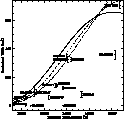In the attempt to study the phase correlations between light and spectral
variations, we have calculated the error on phase. From these calculations
we can see that three stars, HD28843 (He weak), HD182255 (He weak) and
HD223640 (B9SiSrCr), show a
clear anti-phase correlation. The equivalent width of
the HeI5876Å line varies in phase with the photometric variations
for the stars HD43819 (B9 Si), HD171247 (B8Si) and HD176582 (He weak).
As to HD26571 the error on ![]() is too large to draw any conclusion.
In the case of HD177003 (B3 He) nothing can be said since the Hipparcos
light curve has too large a dispersion and a low amplitude.
Hence no unique correlation exists, and this fact is
independent of the spectral types of both groups of stars, which are
all in the B5-B9 range.
This result confirms the one obtained by Catalano & Leone (1996). In an
attempt to clarify the nature of the correlation between light and helium
lines variations, these authors compared the emerging fluxes of two
atmosphere models with the same effective temperature (
is too large to draw any conclusion.
In the case of HD177003 (B3 He) nothing can be said since the Hipparcos
light curve has too large a dispersion and a low amplitude.
Hence no unique correlation exists, and this fact is
independent of the spectral types of both groups of stars, which are
all in the B5-B9 range.
This result confirms the one obtained by Catalano & Leone (1996). In an
attempt to clarify the nature of the correlation between light and helium
lines variations, these authors compared the emerging fluxes of two
atmosphere models with the same effective temperature (![]() =15000 K)
and gravity (log
=15000 K)
and gravity (log ![]() ) but with different helium abundance. The models
were computed by means of the ATLAS9 code (Kurucz 1993) and are
characterized by solar and zero helium abundance. By comparing these fluxes,
they found no observable magnitude differences and concluded that the photometric
variations presented by helium weak stars cannot be entirely ascribed to the
non homogeneous distribution of helium on the stellar surface.
) but with different helium abundance. The models
were computed by means of the ATLAS9 code (Kurucz 1993) and are
characterized by solar and zero helium abundance. By comparing these fluxes,
they found no observable magnitude differences and concluded that the photometric
variations presented by helium weak stars cannot be entirely ascribed to the
non homogeneous distribution of helium on the stellar surface.
Figure 9 shows the measured average value of the equivalent width of the HeI5876Å line together with the theoretical behaviour computed in the NLTE approximation by Leone & Lanzafame (1998) for solar composition stars. We conclude the helium abundance is not peculiar for the stars HD36589, HD43819, HD171247, HD177003, HD182255 and HD209515, while helium is underabundant in the remaining stars. It is worthy note, that the equivalent width of the HeI5876Å line for HD182255 is close to the value of a solar composition main sequence star, even though this star is classified as an helium weak star.
 |
Figure 9:
Behaviour of equivalent width versus effective temperature for our
sample of CP stars. Points represent the observations, errorbar extend by 1 |
This research has made use of the Simbad database, operated at CDS, Strasbourg, France. We would like to thank the referee, Dr. P. Martinez, for his useful suggestions that improved this paper.
Copyright The European Southern Observatory (ESO)